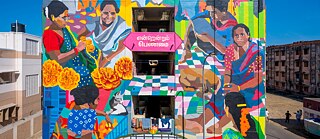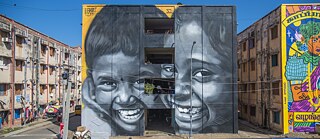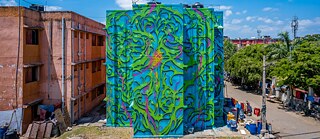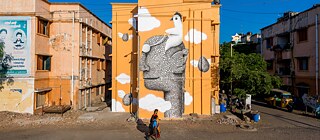Kannagi Art District
Graffity Art in Chennai
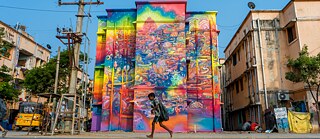
The sea has been in constant conversation with the city of Chennai, allowing, in equal parts, for livelihoods to flourish or perish. Displaced and resettled into Kannagi Nagar due to the 2004 Tsunami, the residents of this locality are not foreign to this notion. Located in the outskirts of Chennai, Kannagi is known as one of the biggest resettlement sites in India. Marred by a negative image, it has been existing on the fringes of society.
Home to 94,000 people, Kannagi has large open spaces dialoguing with imponent buildings whose facades are perfect canvases. Furthermore, its streets are always populated by a community that inhabits them in creative ways, especially by playing the most diverse games. A dense and intense area of the city to discover, Kannagi and its controversial yet vibrant territory was a great ground to continue St+art’s urban explorations.
In February 2020, St+art invited artists to respond to this despondent circumstance of the community by creating murals around the theme of ‘People and Environment'. With a diverse range of styles and techniques, the murals illustrated ideas relating to home, hope, and livelihoods. As an ode to the spirit of Kannagi’s residents, India’s fifth art district took shape to showcase how urban art can regenerate not just a neighbourhood but also the lives that reside within it.
In its first edition, 4 international artists and 11 Indian artists painted over facades all along the perimeter of the neighbourhood. Each one in their different styles focused on specific local narratives that opened up several discussions surrounding climate change and its effect on livelihoods and the city, the value of traditions, women's rights, and much more.
This exploration of locally lived experiences opened up an even more delicate dialogue about ‘resettling’ and ‘displacement’, and the infrastructural and emotional challenges that continue to plague the community.
To bring these stories to the forefront, St+art also facilitated community-based actions in the form of collateral projects, which actively involved the residents in the making of the art district. The invited artists adapted their practice in a context-specific approach through workshops for kids and adults. In collaboration, these workshops led to the creation of smaller murals around the district, serving as permanent remnants of this creative exchange.
Furthermore, St+art collaborated with city-based realities such as Chennai Photo Biennale and Urban Design Collective, amongst others. Each of these organisations hone expertise in mobilising participative community art projects. While on one hand CPB conducted photography lessons for the kids, UDC created a unique study of the street games of Kannagi Nagar, culminating in the creation of a postcard set based on the same. Through these new mediums, creativity arrived in its divergent form for the people of Kannagi, giving them an agency to retell their stories. These projects also ensured an outreach of their outcome into the city, as an effort to permeate the existing social disparities between Chennai and Kannagi.
The resilience of the community lies not only in their effort to re-visualise their life in this outskirt but also in their ability to sustain their creativity while they are at it. While credit for recreational engagement may be given to the several centres in the neighbourhood, its truest form lies within the folds of what the community— of people bound by one reality—shares with one another. When one walks through the endless lanes of the colony, the visual of street creativity is evident—from ground floor apartments being used as grocery stores entirely and artistically painted to abandoned construction sites becoming home to street game tournaments and many dance rehearsals, self-initiated and choreographed by the youth.
Drawing inspiration from these, Kannagi Art District was initiated to shape community living for the residents to further encourage local creativity and culture. The first edition of the festival oversaw a complete transformation of a section of the neighbourhood. In the course of changing its ‘face’ by painting over the facades, the art district created a physical space for celebration and gathering by transforming a rickety open ground. Today, this ground stands surrounding a myriad of murals that redefine the neighbourhood’s identity, whilst becoming a point for education and creativity for its residents. The district was officially inaugurated on 9th March 2020 by eminent ministers part of the Tamil Nadu State Government.
